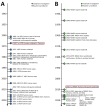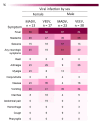Characteristics of Madariaga and Venezuelan Equine Encephalitis Virus Infections, Panama
- PMID: 39530903
- PMCID: PMC11559567
- DOI: 10.3201/eid3014.240182
Characteristics of Madariaga and Venezuelan Equine Encephalitis Virus Infections, Panama
Abstract
Madariaga virus (MADV) and Venezuelan equine encephalitis virus (VEEV) are emerging arboviruses affecting rural and remote areas of Latin America. However, clinical and epidemiologic reports are limited, and outbreaks are occurring at an increasing frequency. We addressed the data gap by analyzing all available clinical and epidemiologic data of MADV and VEEV infections recorded since 1961 in Panama. A total of 168 human alphavirus encephalitis cases were detected in Panama during 1961‒2023. We described the clinical signs and symptoms and epidemiologic characteristics of those cases, and also explored signs and symptoms as potential predictors of encephalitic alphavirus infection compared with those of other arbovirus infections occurring in the region. Our results highlight the challenges for the clinical diagnosis of alphavirus disease in endemic regions with overlapping circulation of multiple arboviruses.
Keywords: Madariaga virus; Panama; Venezuelan equine encephalitis; alphaviruses; outbreak investigation; vector-borne infections; viruses.
Figures







Update of
-
Clinical and epidemiological characteristics of Madariaga and Venezuelan equine encephalitis virus infections.medRxiv [Preprint]. 2024 Feb 3:2024.02.02.24302220. doi: 10.1101/2024.02.02.24302220. medRxiv. 2024. Update in: Emerg Infect Dis. 2024;30(14):94-104. doi: 10.3201/eid3014.240182. PMID: 38352566 Free PMC article. Updated. Preprint.
References
-
- Weaver SC, Dalgarno L, Frey T, Huang H, Kinney R. Togaviridae. In: van Regenmortel MHV, Fauquet CM, Bishop DHL, Carsten EB, Estes MK, Lemon SM, et al., editors. Virus taxonomy: classification and nomenclature of viruses: seventh report of the International Committee on Taxonomy of Viruses. San Diego: Academic Press; 2000. p. 879–89.
-
- Carrera JP, Pittí Y, Molares-Martínez JC, Casal E, Pereyra-Elias R, Saenz L, et al. Clinical and serological findings of Madariaga and Venezuelan equine encephalitis viral infections: a follow-up study 5 years after an outbreak in Panama. Open Forum Infect Dis. 2020;7:ofaa359. 10.1093/ofid/ofaa359 - DOI - PMC - PubMed
Publication types
MeSH terms
Grants and funding
LinkOut - more resources
Full Text Sources
Miscellaneous

